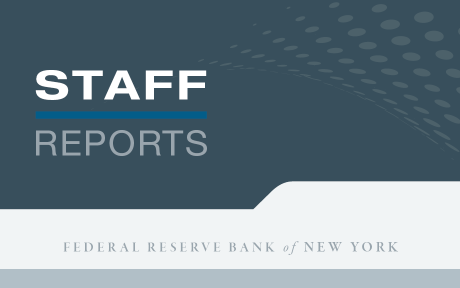
In a companion post, we showed that during the bank run of spring 2023 investors were seemingly not concerned about bank risk broadly but rather became sensitized to the risk of only about a third of all publicly traded banks. In this post, we investigate how the Federal Reserve’s liquidity support affected investor risk perceptions during the run. We find that the announcement of the Fed’s novel Bank Term Funding Program (BTFP), and subsequent borrowings from the program, substantially reduced investor risk perceptions. However, borrowings from the Fed’s traditional discount window (DW) had no such effect.
The Fed’s Liquidity Support Programs During the 2023 Bank Run
The Federal Reserve deployed two main liquidity facilities during the bank run, with different designs. The BTFP, announced on March 12, 2023, allowed banks to borrow against the face value of securities eligible for purchase by the Federal Reserve Banks in open market operations (OMO)—such as U.S. Treasuries, U.S. agency securities, and U.S. agency mortgage-backed securities—with a maturity of up to one year. Banks that had suffered capital losses on these securities when rising rates reduced their prices could post them as collateral to the BTFP and obtain funding equal to their full face value. In contrast, the DW, a long-established liquidity facility, provided short-term funds against the market value of eligible securities, which is lower than the par value for underwater securities. However, the DW accepts a wider range of collateral (both liquid and illiquid) than the BTFP. During this period, neither facility applied a haircut to the borrowing amount.
The chart below shows publicly traded banks’ average unrealized losses on their OMO-eligible securities (called OMO losses from now on) as a share of total assets as of 2022:Q4. Since banks needed to own the OMO collateral as of March 12, 2023, to borrow from the BTFP, banks with greater shares of pre-existing OMO losses were most likely to benefit from the program. Distressed banks (those that would be downgraded in April 2023) had the highest share of OMO losses, followed by the large regional banks (those in the Regional Banking Index, or KRX). By comparison, stress-tested banks, or STBs, and smaller regional banks (those not in any bank index and with assets of at least $10 billion) had relatively low shares of OMO losses.
Distressed Banks Had the Most Losses on Their Liquid Securities
Percent
Notes: The chart shows the mean asset shares of unrealized losses on securities eligible for open market operations (OMO) in 2022:Q4 by groups of publicly traded banks. Distressed banks are those that were downgraded in April 2023. Stress-tested banks are banks that were part of the Federal Reserve’s stress tests in 2022 and part of the broad bank index KBW. Large regional banks consist of non-downgraded regional banks in the KRX bank index. Small regional banks have assets of at least $10 billion and were not included in any bank index.
How Did the BTFP Affect Bank Returns?
If the stock market expected the BTFP to benefit banks, then banks likely to benefit more from the facility should have seen a greater increase in their stock price upon the program’s announcement. This is indeed what we find. Specifically, stock prices of distressed banks with higher OMO losses increased more than 8 percent in the two weeks after the announcement, relative to banks expected to benefit less—a statistically significant difference. In our analysis, we rule out the possibility that the announcement effect was a “bounce back” in stock prices from the sharp fall on March 9 and 10 (the first two days of the bank run).
How Did the BTFP Affect Investor Perceptions of Bank Risk?
We find that investor perception of risks from uninsured deposits and unrealized losses on securities (measured by the UID and Losses betas, respectively, as explained in our companion post) increased with OMO losses in the two weeks prior to the BTFP announcement but decreased with OMO losses in the two weeks following the announcement. For banks with high OMO losses, this decline was substantial. For example, for banks in the 90th percentile of OMO losses, the BTFP announcement almost fully offsets the increased risk perceptions in the two weeks prior to the announcement.
How did risk perceptions change once banks subsequently borrowed from the BTFP? Although the BTFP borrowings were anonymous, they may have been inferred, as with DW borrowings. However, given the significant announcement effects, benefits from actual borrowing may have been largely internalized by investors, implying a weak effect of borrowings on risk perceptions. Moreover, actual borrowing may also have heightened investor risk perceptions if investors inferred that borrowers’ OMO losses were greater than they had anticipated. Indeed, we find no further effect on risk perceptions regarding UID and Losses after borrowings. However, investor perceptions of banks’ cash and capital risk (as measured by the corresponding betas) declined, perhaps reflecting the positive effects of enhanced liquidity from the borrowings.
Discount Window Borrowings
We find that DW borrowings did not affect investor risk perceptions. The different effects of BTFP and DW borrowings could reflect the stricter funding terms of the latter when pledging underwater liquid securities, and the historical stigmatization of the DW. Also, the BTFP directly addressed the specific problem banks faced during the crisis (in other words, underwater liquid securities), which may have enhanced its chances of success.
Final Words
The BTFP strongly reduced investor risk perceptions of banks that carried large amounts of unrealized losses on underwater liquid securities on their books. By credibly committing to lending against the face value of these securities, the Federal Reserve mitigated the market’s concern about the banks being forced to realize losses on their securities portfolios. The announcement of this backstop was enough to calm investor nerves, even before banks used the facility. In contrast to the BTFP, the traditional DW facility did not affect investor concerns about bank risk, suggesting that liquidity programs targeting the specific causes of a crisis may be more effective.
Despite these beneficial effects, there are likely limits to BTFP-style interventions. Distressed banks benefited most from the BTFP, and similar results were found in prior research on the Federal Reserve’s liquidity facilities during the global financial crisis of 2008. Thus, liquidity programs may slow down the resolution of distressed banks, thereby limiting market discipline. On the other hand, resolution of distressed banks during a crisis may have contagious effects even on safer banks, and so delaying such resolutions till the crisis is over may be prudent.
Natalia Fischl-Lanzoni, a former research analyst in the Federal Reserve Bank of New York’s Research and Statistics Group, is pursuing a master’s in computer science at NYU Courant.
Martin Hiti, a former research analyst in the Federal Reserve Bank of New York’s Research and Statistics Group, is a Ph.D. student in finance at the MIT Sloan School of Management.

Asani Sarkar is a financial research advisor in the Federal Reserve Bank of New York’s Research and Statistics Group.
How to cite this post:
Natalia Fischl-Lanzoni, Martin Hiti, and Asani Sarkar, “Calming the Panic: Investor Risk Perceptions and the Fed’s Emergency Lending During the 2023 Bank Run,” Federal Reserve Bank of New York Liberty Street Economics, September 30, 2025, https://doi.org/10.59576/lse.20250930b
BibTeX: View |
Disclaimer
The views expressed in this post are those of the author(s) and do not necessarily reflect the position of the Federal Reserve Bank of New York or the Federal Reserve System. Any errors or omissions are the responsibility of the author(s).













 RSS Feed
RSS Feed Follow Liberty Street Economics
Follow Liberty Street Economics